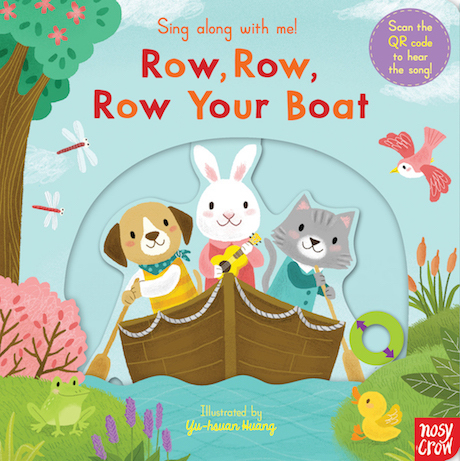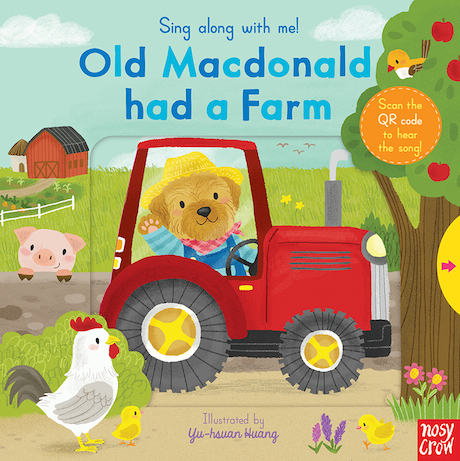Nosy Crow's Blog, page 161
March 5, 2015
It's our March Publication Day!
Today feels like a very auspicious day to be publishing some new books, given the excellent Blue Peter Book Award news of this morning, AND the fact that it is also World Book Day, AND the fact that it’s also the birthday of two of Nosy Crow’s founders, Adrian and Camilla. And happily, we have some truly brilliant new titles out today to do the occasion justice! Here’s what you can find in shops now:
We’re launching a fantastic new nursery rhyme board book series – Sing Along With Me, illustrated by Yu-Hsuan Huang. Each book comes with five slider mechanisms, and both an instrumental and vocal version of the nursery rhyme – simply scan the QR code on the first page for little ones to listen and sing along! Here’s a look at our first two Sing Along With Me books, Old MacDonald Had A Farm and Row, Row, Row Your Boat:
The first two titles in Axel Scheffler’s wonderful Pip and Posy series, The Super Scooter and The Little Puddle, are being published today in a lovely new cased board book format – perfect for very young children. These gorgeous books have real heart (and real-life stories): The Little Puddle is the ideal aid to potty training, while The Super Scooter is a gentle introduction to the concepts of sharing, falling out and making up – all beautifully illustrated by Axel. Here’s a look inside each book:
It’s publication day for The Princess and the Giant, written by Caryl Hart and illustrated by Sarah Warburton – a gorgeous rhyming picture book about the power of bedtime stories. Princess Sophie is EXTREMELY fed up. She can’t get to sleep and it’s ALL because of that grumpy old giant who is stomping about all night. But when Sophie reads her favourite book of fairy tales, she suddenly has a bright idea and figures out EXACTLY what that giant really needs. Here’s a look inside the book:
Funny Face, Sunny Face, written by Sally Symes illustrated by Rosalind Beardshaw is out today – a charming new picture book for the very young, featuring adorable animals, heavenly toddlers, and an exuberant rhyming text. It’s a JOY to read aloud – here’s a look inside:
The paperback edition of Use Your Imagination by Nicola O’Byrne is out now – an inventive, entertaining story about how an imaginative rabbit outwits a wolf and becomes the hero of his own adventure. Here’s a look inside:
And it’s also publication day for the paperback edition of Littleland Around the World by Marion Billet. From New York to Australia, and lots of lands in between, this second Littleland picture book features a stunning scene on every spread and is perfect for developing vocabulary and exploring different cultures. Here’s a look inside:
We’re launching a new series by none other than newly-anointed Blue Peter Book Award winner, Pamela Butchart herself! Written by Pamela and illustrated by Becka Moor, Wigglesbottom Primary: The Toilet Ghost is the brilliant first book in this new series for 5+ year olds. Wigglesbottom Primary is the school where ANYTHING can happen. For example, Jacob Barry’s stinky shoe can ACTUALLY PREDICT THE FUTURE, the boys’ toilets are HAUNTED, and then there’s the CURSE that lives in the story-time carpet and gives everyone ants in their pants! With three hilariously-illustrated stories in each book, this series is perfect for newly-independent readers. Here’s a look inside:
And finally, The Beneath, by S. C. Ransom, is out today – a gripping, atmospheric thriller for 12+ year-olds (perfect for fans of Neil Gaiman’s Neverwhere or China Mieville’s Un Lun Dun) from the author of the acclaimed Small Blue Thing trilogy. It’s an ordinary school day, but Lily is about to step into a nightmare. The girl rushing out of the Tube tunnel tells a crazy story about an underground community and a charismatic leader with an evil plan. How can Lily trust her? It’s only when Lily finds herself in the labyrinth beneath London that she learns the horrific truth – about the Farmer, the Crop and about herself. You’ll never be able to take the Tube again without wondering what lies beneath… Here’s a look inside the book:
Buy the book online.
Congratulations to all of today’s authors and illustrators!
The Spy Who Loved School Dinners by Pamela Butchart wins the Best Story category of the Blue Peter Book Awards
One Wednesday morning in the office a while back now, I was told a literary agent was on the phone for me. The usual cold fingers of panic ran up my spine as I thought about my submissions pile, teetering electronically in my inbox. But it was OK. It was Becky Bagnell, of the Lindsay Literary Agency, merely wishing to add to it.
She’d picked a good time. Almost lunch and finding it hard to type and eat at the same time, I started reading her submission. TIME BOMB TEDDY by Pamela Butchart; it sounded good, and it was short. Cheering things as I only had a small sandwich. I was three lines in before I laughed for the first time. When I’d finished the submission (and the sandwich) I rang Becky back, mayonnaise getting everywhere, and told her how much I’d liked it.
Fast forward through the following months (past meetings in small Spanish restaurants in North London that Kate came to by mistake; past signing tours during which we lost Waterstones; past cut-out cats and lovely Scottish weddings; past editing, and designing, and publication (as BABY ALIENS GOT MY TEACHER!), and writing, and more designing, and selling (always selling) – pause briefly to cheer as Pamela invites a small girl at the RHCB Award up on stage for a crisp – and then press play as Pamela Butchart, and illustrator Thomas Flintham, and second novel THE SPY WHO LOVED SCHOOL DINNERS, only go and win the Blue Peter Award for Best Story! Today!
The winners of the awards were announced this morning on Newsround, and you can catch both Pamela and Thomas on Blue Peter this afternoon, at 5.30pm.
We are, so so pleased for the book, and for Pamela and Thomas! This is such an fantastic award – chosen by over 200 children across the UK – and such wonderful recognition for a truly brilliant book.
Here’s a look inside The Spy Who Loved School Dinners:
Congratulations, Pamela and Thomas!
March 4, 2015
Bid for original, signed artwork by Axel Scheffler and help raise money for War Child
A couple of week ago, Pip and Posy illustrator Axel Scheffler led a fantastic storytelling session to a packed house at the Southbank Centre as part of the Imagine Children’s Festival. And today we’re very pleased to say that we’ll be auctioning some of the work that Axel produced on the day in aid of charity. There are six different pieces available to bid on, featuring some of Axel’s best-loved characters, with all proceeds going to War Child.
War Child is a London-based charity that provides life-changing support to the most vulnerable children whose families, communities and schools have been torn apart by war. Working in Congo, Central African Republic, Afghanistan, Iraq, Uganda, Syria and Gaza, War Child’s vital work includes creating safe spaces where children can escape from battlefields or dangers of life on the streets, getting children into school or informal educaton after conflict or poverty has cost them the chance of an education, helping young people and their families learn the vocational skills they can earn a sustainable income from, and helping children get their voices heard and their rights met, and helping local people to protect their children better.
And here’s what you can bid on right now!
Zog and the Witch from Room on the Broom: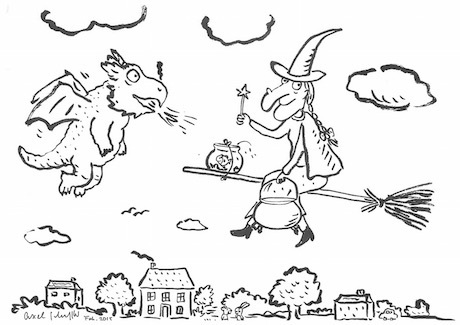
Bid for this artwork.
Pip and Posy and Stick Man: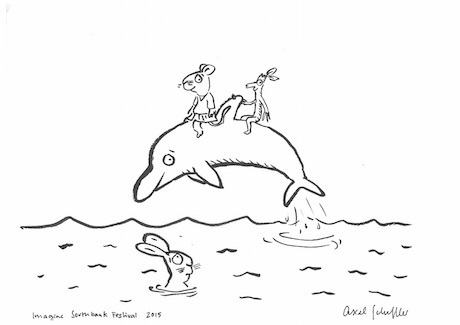
Bid for this artwork.
Pip and Posy and a dinosaur: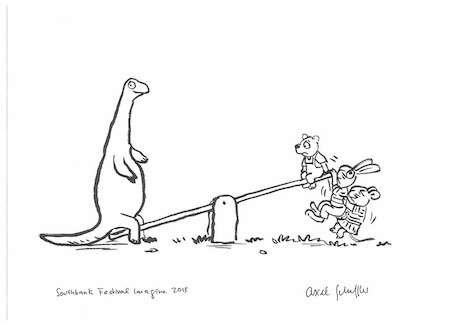
Bid for this artwork.
Pip and Posy and Tabby McTat: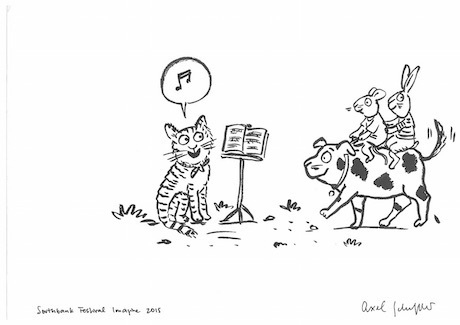
Bid for this artwork.
Pip and Posy and the Gruffalo: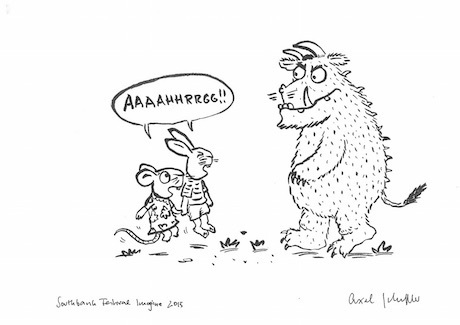
Bid for this artwork.
Pip and Posy: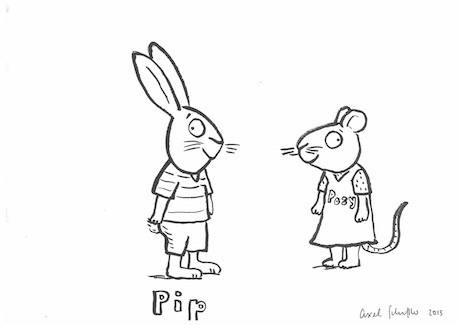
Bid for this artwork.
The auctions will run for 5 days and will end next Monday. So if you’ve always wanted to own a unique piece of artwork by Axel, now’s your chance! Please do bid generously – and good luck!
March 3, 2015
Can apps enhance learning?
Today’s blog post is by Rachel Stohler, mother of Meghan and a publishing MA student at Kingston University.
I bought the Nosy Crow Cinderella app for my five-year-old daughter, Meghan, last fall. We read through it once together and after that, she would look at it on her own every so often. She possessively called it “my app” and enjoyed the “Read and Play” setting.
Last week, I bought the physical version of the book—not for Meghan, but for my MA dissertation. (I am studying Publishing at Kingston University.) Meghan happened to see the book on my desk, and her reaction to it was fascinating.
Before I explain Meghan’s response, I should mention that I’ve become very interested in the development of children’s picture book apps that encourage literacy—apps in which enhancements (interactive elements that move, speak, change color, etc) actually enhance learning. I really want to know if picture book apps can be created to increase engagement, build emotional connections with characters and foster comprehension.
Without my intending it to happen, my daughter provided me with my first observational evidence that carefully designed picture book apps can actually aid literacy development.
When Meghan opened to the first page of the physical Cinderella book, she saw a smiling Cinderella and remarked, “She shouldn’t be smiling. She has to work hard.” She quickly turned more pages and then stopped at the section in which Cinderella is helping the sisters get dressed for the ball. She touched the pile of ribbons and baubles in Cinderella’s arms and grinned conspiratorially. I could tell she felt very clever because of her secret knowledge (that when she touched that picture on the app, the ribbons would move).
Meghan laughed. Then she said, “Can I have my app?”
“Do you want to compare it?” I asked. She nodded.
When I gave her the iPad, Meghan confirmed that on the first “page” of the app, Cinderella sweeps the floor glumly. She is not smiling. She says, her voice exhausted, “Another busy day for me.”
By holding the app and the book side by side, I could see that Meghan was right; Cinderella should not have been smiling. From her experience with the app, Meghan had made enough of an emotional connection with Cinderella that she could articulate the character’s feelings and evaluate how well an illustration conveyed them.
As Meghan continued to compare the physical book and the app, I began to wonder if a carefully developed app could actually enhance a young reader’s emotional connection to a text? Just last weekend I read Proust and the Squid: The Story and Science of the Reading Brain (2008) in which Maryanne Wolf explains: “…emotional engagement is often the tipping point between leaping into the reading life or remaining in a childhood bog where reading is endured only as a means to other ends.” Clearly, emotional engagement plays an important role in the development of what Wolf calls a “fluent, comprehending reader.”
Meghan’s desire to compare two formats of the same book is a fascinating demonstration of engagement with, connection to and comprehension of a text. Research by Warren Buckleiter (2006) suggests that children respond best to interactive media with which they can engage, and in Screen Time (2007), author Lisa Guernsey suggests that “…the strength of electronic books—whether in a child’s lap or on a screen [may be] that they allow children to engage with a book on their own terms.”
My observations of Meghan suggest that apps may have the potential of being more engaging to early readers than physical books. Of course, this is a problem if the apps are just games in the guise of books, but if the apps are actually carefully designed to scaffold learning and enhance the story, it’s possible they may be the most engaging entry into the magical world of stories.
Thank you very much, Rachel! If you’ve not yet tried our Cinderella app (or read the print book!) you can watch a trailer for the app and take a look inside the book below – and if you’d like to stay up to date with all of our app news, you can sign up to our apps newsletter here.
March 2, 2015
Come and work for Nosy Crow: we're hiring a Senior Designer
We are increasing the number of books we publish and branching out into new areas. We are keen to find a senior designer to join our design team. We need someone highly-organised, creative and technically skilled with experience of designing children’s full-colour picture books, and of working closely with illustrators.
This is a full-time role and the successful applicant will be based in the London office of Nosy Crow in Borough (near London Bridge, Borough and Southwark tube stations, and 15 minutes’ walk from Waterloo). We would consider an exceptional candidate who was not able to work full-time in the office, but we’re looking for an absolute minimum of 3 days per week in the Nosy Crow nest.
(If you’re a freelancer with substantial children’s illustrated book design experience who reading this, we’re always interested to have a sense of who’s out there, so by all means get in touch, but this is, as we say, a staff role.)
Candidates will have the right to live and work in the UK and will have a minimum of 3 years’ experience in graphic design, mostly if not exclusively in children’s publishing, and will have worked on picture books, and, ideally, on novelty books too. Proficiency in Indesign, Photoshop and Illustrator programmes, excellent proven book design and typographic skills, and an understanding and love of children’s books and children’s book illustration are essential. We’re also looking for good written and spoken communication skills, and the ability to work efficiently to a deadline.
The successful candidates will manage illustrated book projects (mainly picture books)) from initial layouts all the way through to production, supporting the illustrator or the author/illustrator throughout the creative process. The senior designer will report to the Head of Design and will work closely with more junior members of the team, supporting them as they refine their skills. The senior designer will also work with other members of the Nosy Crow team, particularly the editorial staff, to produce child-focused, parent-friendly, high-quality books.
We are still a small, close team here at The Crow’s Nest working in a friendly, highly creative and professional environment and we need team players who are willing to muck in, particularly during busy times.
If you would like to apply for a role, please send a CV and application letter, along with digital samples of your design work (using a link rather than sending a huge file), to Managing Director Kate Wilson via email (kate@nosycrow.com).
The closing date for applications is 2 April 2015 at midnight (UK time).
February 27, 2015
Six Nosy Crow books in The Reading Agency's Summer Reading Challenge
Exciting times.
We have six titles on The Reading Agency’s Summer Reading Challenge list of titles. The Summer Reading Challenge takes place every year during the summer holidays. Children can sign up at their local library, then read six library books of their choice, collecting free stickers and other rewards along the way. It’s a way of extending reading development through the summer – a time when some children fall behind in their reading. The theme this year is “record breakers”. Libraries work really hard to make the selected books visible, with special display space and posters.
They are (drumroll):
My Brother is a Superhero
Nuts in Space
Superhero Dad
The Shark-Headed Bear-Thing
The Princess and the Giant
Witchworld
Congratulations to all our authors and illustrators.
In 2013, we had the following titles on the list: Shadows of The Silver Screen, Vulgar The Viking and the Spooky School Trip and Shifty McGifty and Slippery Sam
In 2014, the following Nosy Crow titles were chosen: The Princess and Presents, Open Very Carefully, Troll Swap and Baby Aliens Got My Teacher
Come to the April Nosy Crow Reading Group!
Would you like to come to the next Nosy Crow Reading Group?
The book group will be on hiatus for a month, while the Bologna Book Fair (and the preparations leading up to it…) take place, but we’ll be back in April!
And we’ll be discussing two recently-published picture books – one wordless, and one picture-less: The Book With No Pictures, by B.J. Novak, and Journey, by Aaron Becker.
We’ll be meeting on Wednesday, April 22 at 6.30pm, at the Nosy Crow offices – 10a Lant Street, London, SE1 1QR, for a discussion of the books with a glass of wine.
If you’d like to come, just sign up for a ticket using the form below, or at this page. Tickets are free, but very limited! If the book group is full, you can add your name to the waiting list and we’ll let you know if a place opens up.
Event registration for Nosy Crow Reading Group: Picture Books powered by Eventbrite
Here’s a trailer for Journey:
And here’s a video of B.J. Novak reading from The Book With No Pictures:
You can buy The Book With No Pictures online from Waterstones here, and Journey here.
We’ll email everyone some discussion points for the book a little closer to the date – we hope you can join us!
February 26, 2015
The Farm Beneath the Water: Turning Life Into Fiction
Jasper, with duckling friend Lucy on his back
Today’s blogpost is by Helen Peters, author of the Waterstones Children’s Book Prize-shortlisted The Secret Hen House Theatre and the newly published follow-up, The Farm Beneath the Water.
The Farm Beneath the Water and my previous novel, The Secret Hen House Theatre, are both set on the farm where I grew up, and both are inspired to some extent by real people and events. My friends and I really did have a theatre in a shed, and my sister really did have a Bean Club and a pet lamb called Jasper. And when Jasper grew up, he really did have a duckling friend who rode around the farmyard on his back.
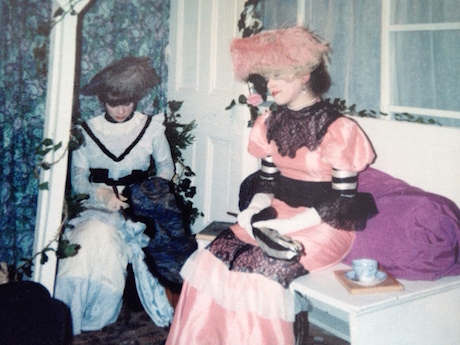
The Lucky Horseshoe Theatre’s production of Murder at the Manor
However, when I decided to write a children’s book set on the farm, I knew it couldn’t just be a random collection of memories. In real life, for example, we put on plays purely for our own amusement. But in a book, the play would have to be for a vital purpose. In The Farm Beneath the Water, the survival of the farm itself depends on the success of Hannah’s play.
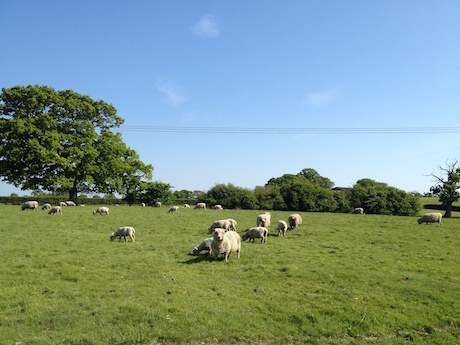
Southdown sheep on the farm
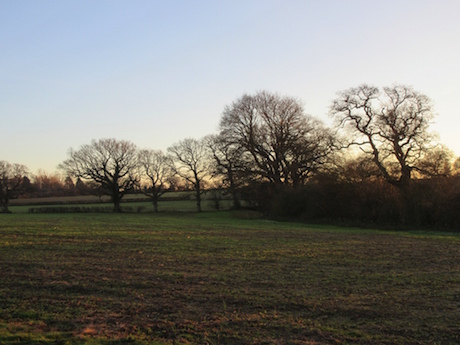
The farm in winter
A friend who read my first version of The Secret Hen House Theatre advised me to make the setting a character in the book. The reader has to understand why Hannah loves her home so much, so the farm has to be a living, breathing entity – a character in the story. It should be so vital to the story that the story couldn’t take place anywhere else.

Some of my notebooks
Until I was given that advice, the farm setting had been vague and imprecise. When I began to redraft the book, I started to visit the farm with a notebook in my pocket. (I’m very lucky that my family still live and work there.) I spent as much time as I could just wandering round observing things: the colours of the lichen on the ancient clay roof tiles; the animal prints in the mud; the buds and blossom in the spring and the berries and changing leaves in autumn. I stood in the farmyard at different times of day, in different weathers and in different seasons, noting down all my impressions. In my notebooks, I try to describe the sensory detail of what I see, not attempting to be poetic, just trying to be as precise as possible about the colours, shapes, textures, sounds and smells.
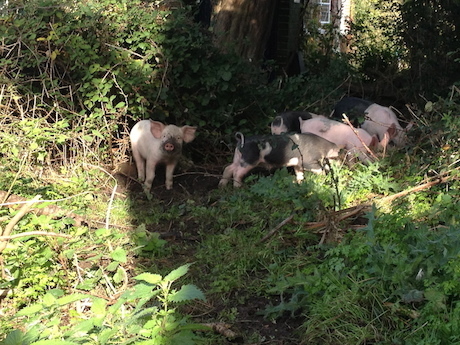
Free range piglets
Of course, the challenge then is to use these notes effectively in the story, so that the descriptions of the farm don’t come in great chunks that slow the story down, but are woven into the narrative. Both my books are told entirely from Hannah’s point of view, so we only see what Hannah sees. Having spent her whole life on the farm, Hannah takes much of her landscape for granted, just as I did, and she only really notices things when they change, with the weather or the seasons or the time of day, or when animals die or are sold or new ones are born or brought in, or of course when they escape, destroy things, and humiliate her by pushing her into puddles or urinating all over her audition costume. I am happy to say that I was never weed on by a piglet during an audition for a school play, but I could only too easily imagine it happening.
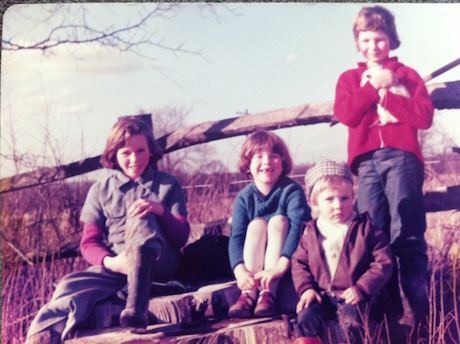
The four of us on the farm
The characters of Hannah and her siblings in my books are inspired by my childhood with three younger siblings. But I found this quite inhibiting at first. How could I presume to know what my sisters and brother had been thinking and feeling? How could I know what really motivated them, what their deepest hopes and fears were?
For some reason, my breakthrough moment came when I started to think about each child’s relationship with the farm. Hannah loves the landscape. Jo loves the animals. Sam loves the whole business of farming: planning which crops to plant, which machinery to buy and which animals to rear. And Martha loathes EVERYTHING about it: the mud on her shoes; the animal hair that sticks to her clothes; the constant background noise of mooing, grunting, bleating and barking; the lack of decent plumbing, heating and carpets and, most of all, the fact that she lives at the end of a mucky pot-holed track miles away from all her friends.
Once I realised what their attitudes were to the farm, I stopped worrying about having to base the children exactly on my siblings, because suddenly these characters started to come alive for me. I found it much easier to write their actions and dialogue, because now I knew how they would act and react.
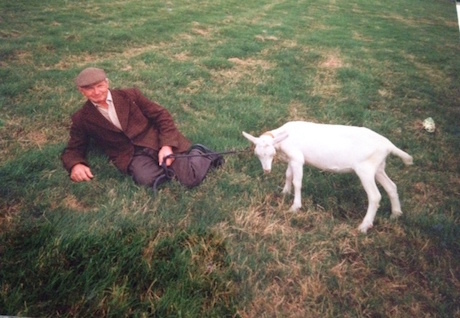
My father with a goat
The character of the children’s father was inspired by my father, who has lived and worked on the farm for over eighty years. My dad is so focused on the farm and so completely uninterested in domesticity that he has never made a cup of tea, let alone a meal, in his entire life. He has always had a mother or a wife to look after him. The family in my books really started to come alive for me when I thought: what if Hannah’s father were widowed? What if these children had no mother, and a father who had no knowledge of or interest in the domestic details of life? What would their lives be like then? And how would Hannah, as the eldest child, balance the chores she has to take on with her passion for theatre?
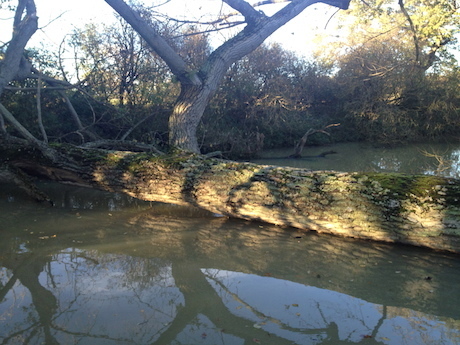
A pond on the farm
The story of The Farm Beneath the Water was inspired by the five-year fight my family and many other members of the local community undertook to stop the farm being flooded and turned into a reservoir. My biggest challenge in writing The Farm Beneath the Water was to convey all the arguments and evidence against the reservoir in a dramatic way. How could I turn the files full of jargon-ridden documents into a story that would keep a ten-year-old child turning the pages?
The answer I came up with was, as is always necessary in a children’s book, to put the children at the centre of the action. In the story, it had to be the children who initiated the campaign to save the farm and who came up with an audacious plan to make the whole village sit up and take notice.
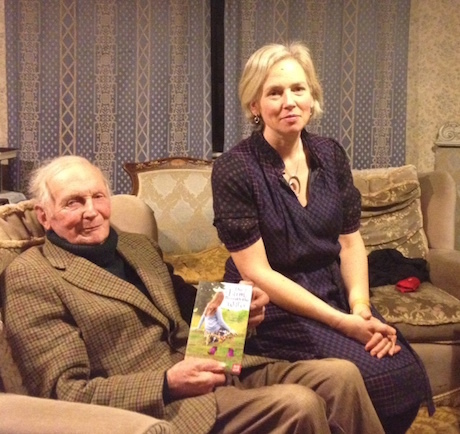
My father and me with the book on his 90th birthday
I received my very first copies of The Farm Beneath the Water just before my father’s ninetieth birthday party (a day he started as he starts every other day, by feeding his pigs). It felt particularly appropriate to be able to give my father the very first signed copy of the book, as without his unwavering commitment to a sustainable way of farming that respects nature and preserves the ancient and beautiful landscape, the story might have had a very different outcome.
Thank you, Helen! The Farm Beneath the Water is out now – you can read the opening chapters of the book below, and order it online here.
February 24, 2015
Helen Peters goes Down the Rabbit Hole
If you’ve never listened to it before (in which case, why not??), Down the Rabbit Hole is a fantastic radio show all about children’s books, broadcast on Resonance FM and hosted by children’s literature extraordinaires Katherine Woodfine, Melissa Cox, and Louise Lamont.
And yesterday’s episode included a feature by Helen Peters, author of the wonderful The Secret Hen House Theatre and the equally-brilliant, just-published follow-up, The Farm Beneath the Water. For her segment, Helen travelled back to the family farm to talk about the inspiration behind her books, the importance of close observation, and turning the farm itself into a “character” in her novels – with lots of authentic mud-squelching, pig-oinking, and chicken-clucking happening in the background…
You can listen to the episode here:
Down The Rabbit Hole – 24th February 2015 by Resonance Fm on Mixcloud
Tomorrow we’ll be posting a fantastic essay by Helen on this blog about growing up on the farm and the inspiration this provided for her books. And in the meantime, if you’ve not yet discovered the book, you can read the opening chapters of The Farm Beneath the Water below, or order it online here.
The challenge of writing a new book - a guest post by 'The Beneath' author S. C. Ransom
Today’s blogpost is by S. C. Ransom, author of the Small Blue Thing trilogy, whose new book, The Beneath, will be out next month.
Writing a new book after completing a trilogy is surprisingly difficult. I hadn’t realised, during the years when I was writing Small Blue Thing, quite how much I had got to know my characters. Writing their speech had become instinctive – I just knew what they would and wouldn’t say, and I had a really clear picture of how they would behave. I was able to put them in a situation and see how it would work itself out.
With a new book all that was gone. I had a blank page – no back story, and nothing was right or wrong. Where to start? One of the places I looked for inspiration was the books my daughter was enjoying. She had piles of dystopian novels, almost all with a futuristic totalitarian regime, a feisty heroine who starts out as an ordinary teenager, and a brooding, handsome hero. What interested me, though, was my reaction as a reader to those dystopian worlds. If I was thrown into The Hunger Games, what would my fighting skill be? How long would I last? Would I have chosen Dauntless if I’d been in Veronica Roth’s Divergent world? How quickly would I have failed all the tests? And something much more interesting to me – how would Katniss survive in our world, not knowing any of the rules that we automatically live by?
Location was easy – there was never any question that the city had to be London. It’s a place I love and know well, and I wanted to explore the secret places which we occasionally glimpse but never get to visit. I worked in central London for many years, commuting in and either walking or getting the Tube, and the city never fails to inspire me. I would also walk around the back streets in my lunch break, looking for details which I could slip into the story, and I discovered an enormous amount about the infrastructure which is buried – and sometimes forgotten – under our feet.
I started to think about a contemporary story set in London, but colliding with a dystopian world. What if there was a whole community of people who lived secretly deep below the Tube network – people who had never walked in a park or drunk a coffee in Starbucks? How would someone from there deal with going on a bus? And how would someone from our world – a normal girl preparing for her GCSEs – survive in a subterranean society with a very different set of rules?
I still wanted to write about teenage friendship, and this time the focus had to be action. I couldn’t abandon the romance completely, but I knew that there should much less of it than in the Small Blue Thing books. The Beneath is centred around a friendship where things don’t work smoothly, and where the two main characters, Lily and Aria, argue and fall out sometimes. I ended up writing the book from both of their points of view – Lily is a teenager commuting to her school in the suburbs, and Aria is on the run having escaped from the community hidden under London. It was fun finding their voices and working out what would make them tick, and inevitably it took a few drafts to get them right.
Writing a stand-alone is much, much harder than completing a trilogy, but I loved creating a new world, building it up in my mind’s eye until I knew it well enough to let some new people in.
I hope that you enjoy it!
Thank you, Sue! The Beneath will be published on March 5 – you can read the first chapter below, and pre-order the book online here.
Nosy Crow's Blog
- Nosy Crow's profile
- 35 followers


